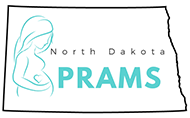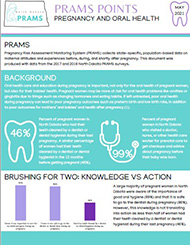Ask A Researcher
May 2021
NEW! PRAMS Points – A Brief Infographic using North Dakota PRAMS Survey Data
The North Dakota Department of Health and the Center for Social Research (CSR) at North Dakota State University (NDSU) continue their collaboration with the North Dakota Pregnancy Risk Assessment Monitoring System (PRAMS), a project that focuses on gathering state-specific data on maternal attitudes and experiences before, during, and shortly after pregnancy to improve the health of mothers and infants. Chelsey Hukriede is a research specialist at the CSR and serves as the Project Coordinator for two statewide surveillance projects, PRAMS and North Dakota Study of Associated Risks of Stillbirth (SOARS). Chelsey earned her master’s degree in Sociology from the University of North Dakota. Kendra Erickson-Dockter is a research specialist with the CSR and provides support for projects, such as PRAMS, SOARS, and North Dakota Compass. Kendra received her master’s degree in Sociology and is a doctoral student in Human Development at NDSU.
The Pregnancy Risk Assessment Monitoring System (PRAMS) is a collaborative surveillance project of the Centers for Disease Control and Prevention (CDC), the North Dakota Department of Health, and the Center for Social Research (CSR) at North Dakota State University. PRAMS collects state-specific data on maternal attitudes and experiences before, during, and shortly after pregnancy, with the overall goal of reducing infant morbidity and mortality.
To help disseminate study results, a series of PRAMS analysis documents will be released on a variety of topics such as oral health, prenatal care, chronic disease, and substance use. First to be released in this series is PRAMS Points: Pregnancy and Oral Health, a brief infographic looking at oral health care among pregnant women in North Dakota. The document was produced with North Dakota PRAMS survey data collected in 2017 and 2018.
This article overviews the data points regarding pregnant women’s oral health in North Dakota that appear in the first PRAMS Points.
Oral Health Background
Oral health care and education during pregnancy is important, not only for the oral health of pregnant women, but also for their babies' health. Pregnant women may be more at risk for oral health problems like cavities or gingivitis due to things such as changing hormones and eating habits. If left untreated, poor oral health during pregnancy can lead to poor pregnancy outcomes such as preterm birth and low birth rate, in addition to poor outcomes for mothers’ and babies’ oral health after pregnancy (2).
Nearly half of all pregnant women in North Dakota had their teeth cleaned by a dentist or dental hygienist during their last pregnancy (46%). Yet, almost all pregnant women in North Dakota visited a doctor, nurse, or other health care worker for prenatal care to get checkups and advice about pregnancy before their baby was born (99%).
Brushing for Two: Knowledge vs Action
A large majority of pregnant women in North Dakota were aware of the importance of good oral hygiene (89%) and thought it was safe to go to the dentist during pregnancy (86%). However, this knowledge is not translating into action, as less than half of pregnant women in North Dakota had their teeth cleaned during this time (46%).

Barriers to Oral Health Care
Pregnant women in North Dakota had few barriers (e.g., could not afford, lack of transportation or insurance) that made it hard for them to go to a dentist or dental clinic. The largest barrier for women to go to a dentist or dental clinic during their most recent pregnancy was lack of dental insurance (28%), followed by affordability (15%).

Room for Improvement
Sizeable health care gaps stand out when examining data associated with oral health care while pregnant in North Dakota by race/ethnicity, age, education, and income.
- Twice the percentage of white women compared to that of minority women had their teeth cleaned by a dentist or dental hygienist during their pregnancy (52% compared to 23-27%, respectively).

In North Dakota as age, educational attainment, and income levels increase, so does the likelihood of pregnant women going to the dentist or dental hygienist to have their teeth cleaned during their pregnancy.
- Twice as many women who are 40 and older compared to teenage women got their teeth cleaned while pregnant (61% compared to 31%, respectively).
- Nearly 4 times the percentage of women with education higher than a bachelor's degree compared to those without a high school diploma got their teeth cleaned while pregnant (75% compared to 19%, respectively).
- Nearly 3 times the percentage of women with incomes greater than $85,000 compared to those with incomes of $24,000 or less got their teeth cleaned while pregnant (68% compared to 25%, res pectively).
 Conclusions
Conclusions
Routine dental checkups and teeth cleanings during pregnancy are safe and important to women's oral health, which contributes to their and their babies' overall health during and after pregnancy (1). Other types of dental procedures, such as x-rays and cavity fillings, are safe to have done during pregnancy when necessary. Although North Dakota PRAMS survey results indicate that most women knew of the importance of good oral care during pregnancy, there appears to be a disconnect between knowledge and action.
This analysis does not offer insight into why pregnant women are not going to their dental providers for routine care, but these data illustrate that many pregnant women in fact are not seeking care even when there appears to limited knowledge or financial barriers. Pregnant women may be avoiding the dentist for a number of reasons: visit is unnecessary or oral health problems were not that serious, no time to go, transportation, inconvenient clinic hours, cost, poor quality of care, wait times, or belief they have a 'healthy mouth' (3).
Recommendations
Analysis of the PRAMS 2017 and 2018 data set indicates that substantial health care disparities exist. There is a need for ongoing programming and outreach activities to address oral health care disparities.
Further discussion and educational campaigns on the importance of good oral hygiene practices and going to the dentist for regular and emergency care should be performed to encourage and remind women to seek dental care during pregnancy, in addition to education regarding potential risks of not maintaining good oral health during and after pregnancy.
Oral health education cannot solely fall on the shoulders of dental professionals. According to these data, women before and during pregnancy are more likely to see other types of health care providers, which may suggest a more collaborative partnership approach across health care professions to support better oral health care education.
PRAMS Information
In addition to more information about the PRAMS project and PRAMS data, these NEW PRAMS Points will be available at www.health.nd.gov/prams.
PRAMS Points Contributors
PRAMS Points and this article were prepared by the Center for Social Research at North Dakota State University for the North Dakota Department of Health. Contributors of the PRAMS Points are Nancy Hodur, Center Director; Kendra Erickson-Dockter, Research Specialist; Chelsey Hukriede, PRAMS Coordinator; and Elvis Ndembe, Research Specialist.
References
(1) American Dental Association. Is It Safe To Go To the Dentist During Pregnancy? Retrieved from: http://www.mouthhealthy.org/en/pregnancy/concerns
(2) Pregnancy and oral health. (2019, February 19). Retrieved February 2021, from: https://www.cdc.gov/oralhealth/publications/features/pregnancy-and-oral-health.html
(3) Taber, Leyva, Persoskie (2014). Why do people avoid medical care? A qualitative study using national data. National Cancer Institute, National Institutes of Health, MD, USA


